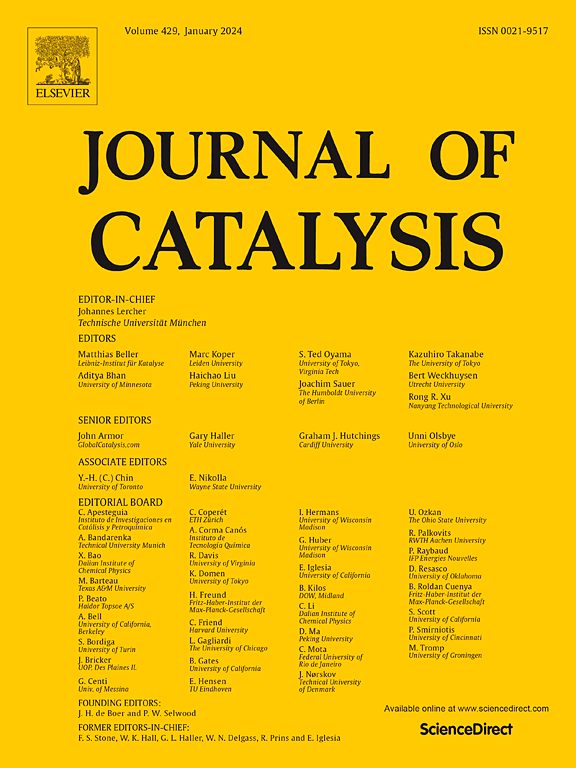利用operando粉末x射线衍射计算机断层扫描研究异型沸石催化剂挤出物再生的时空
IF 6.5
1区 化学
Q2 CHEMISTRY, PHYSICAL
引用次数: 0
摘要
我们使用参数Rietveld精细分析的operando粉末x射线衍射计算机断层扫描(PXRD-CT)来监测在甲醇-烃反应中用作催化剂的失活ZSM-5沸石基挤出物的再生。因此,这项研究超越了以前对纯粉状沸石的研究。我们通过监测三个基于XRD的描述符来跟踪焦炭的氧化。晶格弛豫,通过监测a-和b-晶格参数(a-b)长度的差异,首先发生在挤出物的核心,然后向外表面发展。这表明了不同焦炭种类的径向分布,其中最重的,更抗氧化的焦炭在挤出物的外表面附近成熟。相比之下,在整个挤出过程中,总非骨架物质质量(NFSM)的下降更为均匀,这表明焦炭物质的化学转化可以在完全氧化之前发生。这一观点得到了原位温度程序化氧化的支持,这表明ZSM-5/粘合剂复合材料的再生发生在两个不同的步骤中。我们还观察到,在再生过程中,不可逆的(水力)热损伤发生在挤压物的严重焦化区域。此外,我们还证明了三种不同的基于XRD的描述子所携带的信息略有不同和互补。(a-b)描述符描述由刚性焦炭引起的晶格畸变。相比之下,总非骨架物种质量(NFSM)和单位细胞体积(UCV)捕获了所有客体物种,包括挥发性化合物和水。然而,作为一个缺点,UCV也受到热效应的强烈影响,而(NFSM)实际上不受温度的影响。本文章由计算机程序翻译,如有差异,请以英文原文为准。


Spatiotemporal investigation of the regeneration of a shaped zeolite catalyst extrudate using operando powder X-ray diffraction computed tomography
We have used operando powder X-ray diffraction computed tomography (PXRD-CT) analysed by parametric Rietveld refinements to monitor the regeneration of a deactivated ZSM-5 zeolite based extrudate employed as a catalyst in the methanol-to-hydrocarbon reaction. This investigation thus advances beyond previous studies of pure, powdered zeolites. We follow the coke oxidation by monitoring three XRD based descriptors. Lattice relaxation, monitored as the difference in length of the a- and b-lattice parameters (a-b), occurs first at the core of the extrudate and progresses towards the outer surface. This demonstrates a radial distribution of different coke species, wherein the heaviest, more oxidation resistant coke is matured near the external surface of the extrudate. In contrast, the total non-framework species mass (NFSM) decreased more uniformly throughout the extrudate, suggesting that chemical transformations of the coke species can occur prior to full oxidation. This notion is supported by in situ temperature programmed oxidation, which demonstrates that the regeneration of the ZSM-5/binder composite occurs in two distinct steps. We also observe that irreversible (hydro)thermal damage occurs in the severely coked regions of the extrudate during regeneration. Additionally, we demonstrate that the three different XRD based descriptors carry slightly different and complementary information. The (a-b) descriptor describes lattice distortion induced by rigid coke species. The total non-framework species mass (NFSM) and the unit cell volume (UCV), in contrast, capture all guest species, including volatile compounds and water. However, as a drawback, the UCV is strongly influenced also by thermal effects, whereas the (NFSM) is virtually unaffected by temperature.
求助全文
通过发布文献求助,成功后即可免费获取论文全文。
去求助
来源期刊

Journal of Catalysis
工程技术-工程:化工
CiteScore
12.30
自引率
5.50%
发文量
447
审稿时长
31 days
期刊介绍:
The Journal of Catalysis publishes scholarly articles on both heterogeneous and homogeneous catalysis, covering a wide range of chemical transformations. These include various types of catalysis, such as those mediated by photons, plasmons, and electrons. The focus of the studies is to understand the relationship between catalytic function and the underlying chemical properties of surfaces and metal complexes.
The articles in the journal offer innovative concepts and explore the synthesis and kinetics of inorganic solids and homogeneous complexes. Furthermore, they discuss spectroscopic techniques for characterizing catalysts, investigate the interaction of probes and reacting species with catalysts, and employ theoretical methods.
The research presented in the journal should have direct relevance to the field of catalytic processes, addressing either fundamental aspects or applications of catalysis.
 求助内容:
求助内容: 应助结果提醒方式:
应助结果提醒方式:


